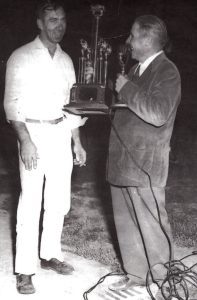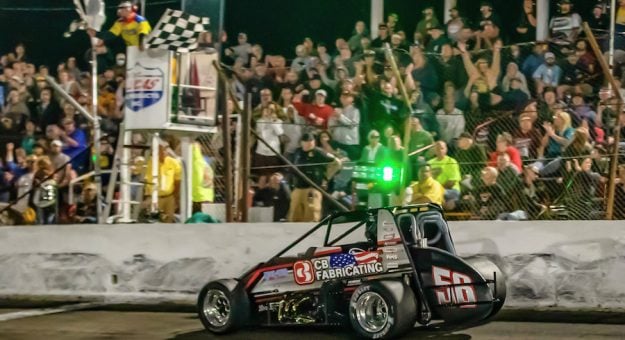The Little 500, run on Memorial Day weekend at Anderson (Ind.) Speedway, is a fan favorite and is known to many as “The Greatest Short-Track Race in the World.”
The 500-lap, non-winged sprint car race is a one-of-a-kind event. Thirty-three sprint cars in 11 rows of three race 500 laps on a high-banked, quarter-mile asphalt track, with live pit stops.
There is no other sprint car event like it. This year, the race will celebrate its 75th running before an expected sold-out crowd; further proof of how popular the event is among short-track fans.
The story of how the race came to be has been told a million times.
Then Sun Valley Speedway (now Anderson Speedway) owner Joe Helpling finished construction of his shiny new speed plant midway through the 1948 season. After five consecutive weeks of rainouts, Dick Frazier won the speedway’s inaugural event, a 25-lap Mutual Racing Ass’n roadster race on July 2, 1948. The speedway finished its inaugural season on a high note, running weekly AAA midgets and MRA roadster programs.

In early 1949, Helpling invited MRA officials, drivers, car owners and local media to an Anderson hotel for dinner, offering little details about the meeting’s agenda. Helpling told Tri-State Racing News in 1973, during an exclusive interview, how the race came to be.
“I had a big 4-by-8-foot plywood sheet covered with paper so you couldn’t see what was on it,” explained Helpling. “I stood that out there in front of everybody. I said, when I get ready, I’m gonna tear the paper off this board and you’ll see what’s on it. Don’t say anything. Just read what it says for the next two minutes. Keep repeating what it says. After that we’ll start talking.”
The sign read: “FIRST ANNUAL LITTLE 500 — STARTING 33 CARS 500 LAPS TO GO.”
“Well, they wanted to change it to 200, 250 or 300 laps. They said it would cost $800 for tires and no cars would finish. Then we’ll run bicycles,” Helpling said. “Cause we’re gonna have a Little 500 and that’s the way it’s gonna be. I’m giving Mutual the first chance. Do you want it or not?”
Mutual agreed to sanction the event and the first Little 500 went off without a hitch.
Despite early skepticism, 24 of the 33 starters were still running at the end. Muncie, Ind., driver Sam Skinner won that inaugural event on May 27, 1949. He covered the distance in 2 hours, 29 minutes and 16.22 seconds.
For several years, it was suggested by locals that the Little 500 concept was the brainchild of Helpling and his PR guy, Bob Hopkins.
Race fans may be astonished to know there were 500-lap midget events at the Los Angeles Memorial Coliseum (1947) and in San Antonio, Texas, that were very similar to the Little 500 and contested well before Helping’s 1949 announcement.
In fact, the Little 500 was most certainly a copy of other existing events; just perfected, unlike these other long-forgotten 500-lap contests.
Storey-Wood Park Speedway in San Antonio played host to three 500-lap midget races from 1947-’49. The races started with 33 cars in 11 rows of three with live pit stops. The events were contested on a flat, half-mile dirt track.
The event was dubbed the “San Antonio 500” and later the “National 250 Mile Midget Auto Championship, for the General Jonathan M. Wainright Cup.” The event honored Wainright, who was a career Army officer and the commander of Allied forces in the Philippines at the time of Japan’s surrender during World War II
The Storey-Wood Park events featured total purses of more than $10,000. The 1948 race advertised the winner would also receive the new Nash pace car in addition to the $5,000 winner’s prize.
The Labor Day weekend event featured two days of qualifications and the 500-lap finale was run on Labor Day Monday. Interestingly, the event featured four-lap time trials, much the same as the Indy 500 and Little 500.
The event was known as the nation’s longest midget race with a distance of 250 miles. Sam Hanks, Jud Larson, Doc Cossey, Bob Carrol, Conky Benson, Cecil Zent, Norman Haltkamp and Saylor Condor were among the drivers who participated. The event ceased after 1949 when only 23 cars participated. The speedway closed in 1950 and the property became a subdivision.
Carrell Speedway in Gardena, Calif., hosted 500-lap roadster races in 1948 and ’49. These events were sanctioned by the California Roadster Ass’n and paid $2,000 to the winners. These were the longest and richest races in the history of CRA up to that point.
